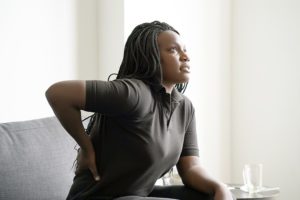Conservative & Surgical Ruptured Disc Treatment From Orthopedic Spine Surgeons in Freehold & Monroe Township, NJ
 The spine is made up of a series of stacked bones (vertebrae) that are separated by small, shock-absorbing cushions (discs). Each disc consists of a tough, outer layer (annulus fibrosus) that contains a gel-like inner core (nucleus pulposus). A ruptured disc occurs when the annulus fibrosus tears, allowing some of the nucleus pulposus to seep into the spinal canal, which houses the spinal cord and nerve roots. While a disc can rupture through direct trauma or excessive strain, the most common cause is age-related spinal degeneration.
The spine is made up of a series of stacked bones (vertebrae) that are separated by small, shock-absorbing cushions (discs). Each disc consists of a tough, outer layer (annulus fibrosus) that contains a gel-like inner core (nucleus pulposus). A ruptured disc occurs when the annulus fibrosus tears, allowing some of the nucleus pulposus to seep into the spinal canal, which houses the spinal cord and nerve roots. While a disc can rupture through direct trauma or excessive strain, the most common cause is age-related spinal degeneration.
Ruptured discs do not always produce symptoms. However, because the spinal canal is a very limited space, displaced disc material can potentially press on sensitive nerve tissue. Depending on the location of an affected nerve, it may produce neck or back pain, muscle weakness, numbness, or tingling sensations that travel down an arm or leg.
How Is a Ruptured Disc Treated?
If a ruptured disc produces back pain or other symptoms, treatment usually begins conservatively with activity modifications to minimize strain on the damaged disc. Complete bed rest is not recommended since prolonged inactivity can actually do more harm than good. A better option is a customized physical therapy program, which may include stretches, exercises, therapeutic massage, hot/cold therapy, ultrasound therapy, and/or electrical stimulation.
Nonsteroidal anti-inflammatory medications can also help relieve painful inflammation in the spine. If further relief is needed, an epidural steroid injection may be considered. Utilizing a spinal needle under X-ray guidance, a physician can precisely place a powerful anti-inflammatory medication directly into the painful area of the spine.
Surgical Treatment for a Ruptured Disc
If ruptured disc symptoms persist or worsen after several weeks or months of conservative treatment, surgery may be considered. Depending on the nature and location of the issue, a physician may suggest a spinal decompression procedure, such as:
- Discectomy – Removal of all or part of a damaged disc
- Laminectomy – Removal of the bony vertebral arch (lamina)
- Laminotomy – Removal of part of the lamina
To enhance the stability of the spine, an instrumentation and fusion procedure may be performed in conjunction with spinal decompression surgery. During this procedure, a surgeon places a bone graft in a weakened area of the spine and secures it with instrumentation, such as screws or rods, to encourage two vertebrae to fuse together and form one solid piece of bone.
In sum, there is no single “right” way to treat a ruptured disc. In recognition of this, the board-certified, orthopedic spine surgeons at Advanced Orthopedics and Sports Medicine Institute provide highly individualized treatments for spine conditions, and we emphasize conservative therapies whenever possible.
Contact AOSMI to learn more about ruptured disc treatment options we offer in Freehold and Monroe Township, New Jersey.







